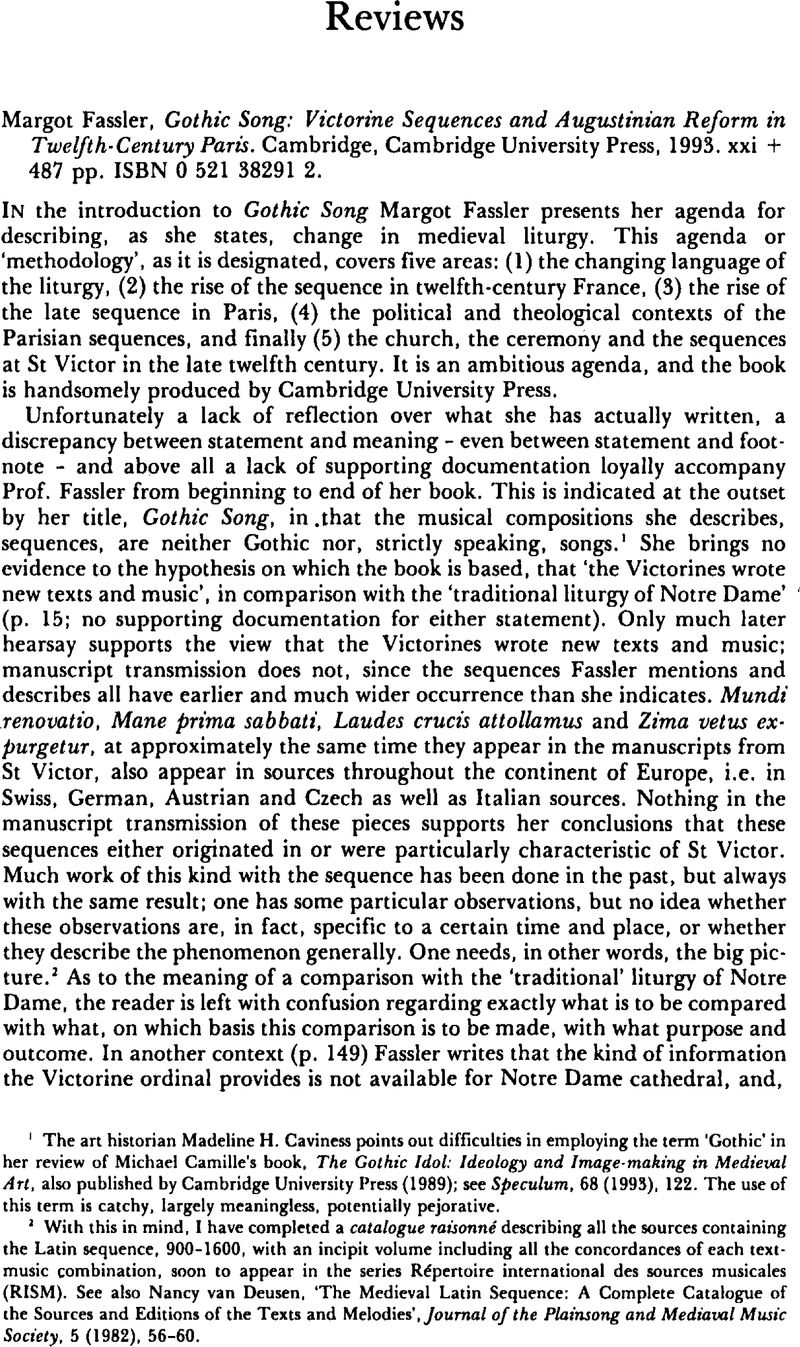Published online by Cambridge University Press: 01 January 2020

1 The art historian Madeline H. Caviness points out difficulties in employing the term ‘Gothic’ in her review of Michael Camille's book, The Gothic Idol: Ideology and Image-making in Medieval Art, also published by Cambridge University Press (1989); see Speculum, 68 (1993), 122. The use of this term is catchy, largely meaningless, potentially pejorative.Google Scholar
2 With this in mind, I have completed a catalogue raisonné describing all the sources containing the Latin sequence, 900–1600, with an incipit volume including all the concordances of each text-music combination, soon to appear in the series Répertoire international des sources musicales (RISM). see also van Deusen, Nancy, ‘The Medieval Latin Sequence: A Complete Catalogue of the Sources and Editions of the Texts and Melodies’, Journal of the Plainsong and Mediaval Music Society, 5 (1982), 56–60.Google Scholar
3 Cf. Nancy van Deusen, ‘The Sequence Repertory at Nevers Cathedral’, Basler Studien zur Interpretation der alten Musik: Forum musicologicum, 2 (1980), 44–59.Google Scholar
4 All these points are substantiated in Nancy van Deusen, ‘The Use and Significance of the Sequence’, Musica disciplina, 40 (1986), 1–46. Prof. Fassler repeats a suggestion that sequences were commentaries to the Alleluia, but neither the commentary format nor the relationship, commentary to text, is in any respect, visually or contextually, present. This further creates an unbalanced view of the sequence as being related solely to the Alleluia; the genre is also connected to an important part of the Mass ceremony, the Gospel reading, a connection made clear in manuscript format, in rationalia, and most importantly within the sequence texts themselves.Google Scholar
5 In her discussion of Nevers cathedral Fassler concludes that ‘if the assignment of lat. 3126 of St. Martin is correct, then the Augustinians of Nevers cared a great deal both about sequences and about the place in the liturgy where they were sung’ (pp. 103–4). I have argued that Nevers as a cathedral milieu contained multiple influences within its corporate structure, in contradistinction to monastic communities, and that cathedrals must therefore be compared with other cathedrals; cf. commentary volume to Music at Nevers Cathedral: Principal Sources of Medieval Chant, 2 vols. (Binningen, 1980), and ‘Music at Nevers Cathedral: Relationships between a Medieval Institution and Manuscript Transmission’, Musicology (Journal of the Australian Musicological Society), 7 (1982), 30–40.Google Scholar
6 See van Deusen, Nancy, ‘A Theory of Composition’, Theology and Music in the Early University: The Case of Robert Grosseteste and Anonymous IV (Leiden and London, 1994), 127–45.Google Scholar
7 See Cassiodorus, , Expositio psalmorum, ed. Marcus Adriaen, Corpus Christianorum series latina, 97–8 (Turnhout, 1958), ii, 837.4: ‘Merito ergo talis calculus totius redemptions nostrae continet formam, qui per obliquas lineas charactere suo sanctae crucis imitatur figuram et in digit is decori circuii rotunditate concluditur.‘Google Scholar
8 Christ as head of the church has a long and widespread medieval exposition, not only within the psalm commentary but also within the Genesis commentary traditions. Cf. Cassiodorus, Expositio psalmorum, i, 183.4: ‘Corona enim non improbe circumeuntium disciplinorum videtur significare conventum quia ipsum docentem desiderantium apostolorum circuitus ambiebat. Haec est corona capitis, hos regale diadema, quod non ornaret impositum sed de Christo Domino poti us ornaretur. In hac enim corona et totius mundi circulum merito poterimus advertere; in quo generalis significa tur Ecclesia.’ Cassiodorus was influenced by Augustine, De Genesi ad litteram. Robert Grosseteste, c. 1222–35, referring to Jerome, brings into the discussion of Christ as caput ecclesie Christ's statement (John, iv. 34) ‘My meat is to do the will of him who sent me, and finish his work’: ‘Inde igitur pascitur Christus, unde in se vel in nobis et nos in ipso voluntatem Patris et opus perficimus; nec aliunde convenit nos pasci, qui sumus eius membra, quam unde pascitur ipse, qui est nostrum capud.’ The head, of course, chews. (Hexaemeron, ed. Richard C. Dales and Servus Gieben O.F.M., Auctores Britannici medii aevi, 6, London, 1982, 261; cf. van Deusen, Theology and Music in the Early University, 151.)Google Scholar
9 An example occurs on p. 21: ‘From these subjects comes an explanation of medieval views of human language and its expressive powers, one which relates directly to the kinds of changes in these views which have recently been the focus of study in other fields, in communication theory and literacy criticism, and in the writings of the art historian Michael Camille.’ The accompanying footnote reads: ‘See especially the writings of Brian Stock which have influenced the work of medievalists in several disciplines.’Google Scholar